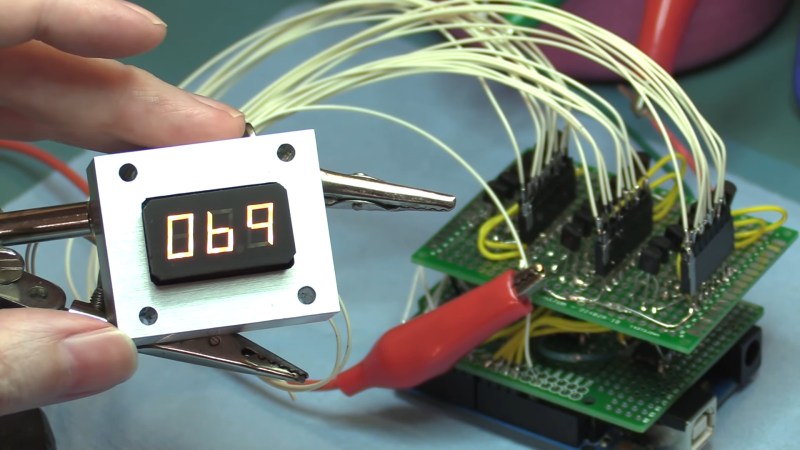When we think of 7-segment displays as the ubiquitous LED devices that sprung into popularity in the 1970s. However, numbers have existed for a lot longer than that, and people have wanted to know what the numbers are for quite some time, too. Thus, a variety of technologies were used prior to the LED – such as these magnificent incandescent 7-segment displays shown off by [Fran Blanche].
The displays are basic in concept, but we imagine a little frustrating in execution. Electronics was tougher back in the days when valves needed huge voltages and even a basic numerical display drew a load of current. Built to industrial-grade specifications, they’re complete with a big heatsinking enclosure and rugged gold-plated connectors. [Fran] surmises that due to the likely military applications of such hardware, the filaments in the bulbs were likely built in such a way as to essentially last indefinitely. The glow of the individual segments has a unique look versus their LED siblings; free of hotspots and the usual tapered shape on each segment. Instead, the numerals are pleasingly slab-sided for a familiar-but-not-quite aesthetic.
[Fran] demonstrates the display running with a CD4511B BCD-to-7-segment decoder, hooked up with a bunch of 3904 power transistors to get the chip working with filament bulbs instead of LEDs. It’s a little fussy, but the displays run great with the hardware sorted.
We’d love to see these used on a very heavy ridiculous watch; nixies aren’t the only game in town after all. If you do happen to make one, be sure to let us know. Video after the break.
















And then,
Numitrons
Like, huh, https://hackaday.io/project/26068/ for example :-D
Given the atrocious efficiency of teeny incandescents; does anyone know if (perhaps for larger applications?) anyone ever went with a single bulb combined with a bunch of mechanically shuttered lightguides?
You certainly don’t need anything remotely close to proper fiber optics to guide light a short distance from a source to a specifically-shaped illuminated region; and teeny little electromechanical shutters certainly show up in lens packages all the time; so this implementation would clearly be possible; I’m just not sure if doing it this way would be stupidly costly or inefficient (or, perhaps more important for those military applications, vibration sensitive) compared to putting up with a bunch of grain-of-wheat incandescents.
One can just cut a piece of acrylic into a rectangle with small light guide at one end and engrave it with a digit. Then just stack ten of them, add small incandescent bulb for each of them and drive them by transistors or relays. Some older electronic calculators did it that way, and even DSKY displays from Apollo missions were done that way, IIRC…
I had an 8 track player that did just that to display the current track number.
In 1974 build ,as shool project, big 10×20 cm seven sement display’s where every segment had 3 bullbs (24v 3W) switched on by a thyristor what was driven from a 7447. So every digit ,8 total, used 63 W what came from a bridge rectiffied 24v AC transformer of 750 VA with a magnetic stabilistion done with/by a capacitor, 180..260v input range with a stable +- .5% output. That was te first time i ever had seen and used such a trafo.
Franlab covered the BINA-VIEW, which has a single lamp: https://www.youtube.com/watch?v=yFV4AOjrdO0
Crazy thought. couldnt someone make single digit ones with the new edison bulbs? use a MAX7219.
17min YT video for an incadent 7=seg display? 8)
This has to stop!
It does have the pointed ends, they just did a very good job minimizing the blackout spaces. I always disliked those big gaps. Thin metal vs. molded plastic makes a difference.
Wow, I just saw the “circle reader service card 26” at the bottom of the ad. I remember doing those to get all kinds of cool mail.
Those expensive-looking micro-D connectors are still a current standard for Spacewire, a satellite data bus standard. They are a little chunky for cubesats, but pretty common on anything bigger. It’s a very neat standard. https://en.wikipedia.org/wiki/SpaceWire
I have kicking around somewhere a 7-segment + decimal point incandescent module in a dip package that I got from radio shack a long time ago. It is basically a black plastic box, with a rectangular slab of glass as a cover, evacuated inside, and filaments for each segment. I think it is rated 5v. I do remember blowing up a bunch of them by accidently banging them when the filaments were lit….but they have a nice color temperature.
“3904 power transistors” … nope. Small signal transistors.
Light Emitting Resistors, noice!
Bit late to the party but I’ve found these displays typically in old aircraft radios. They are very valuable and Wamco still produces them – Boeing is a customer anyway and Boeing themselves sell them to avionics repair shops.
I pulled apart an old radio with 5 digits, whilst 3 were OK, the remaining 2 were worn out and had bright spots on the filaments. They can be subsituted in projects that are designed for 7 segment displays (can’t use them on constant current LED display drivers though) and they don’t need current limiting resistors. The ones I have run off 4V and consume 15mA per segment. They get hot!
Made a short blog article on them https://www.adrian-smith31.co.uk/blog/2024/02/connecting-vintage-incandescent-filament-displays-to-a-microcontroller/
This makes me go “screw typical LED 7-segment displays”! This incandescent style looks so much nicer, frankly. One application I’ve seen this used in was over a decade on Jeopardy for the contestants’ scores.